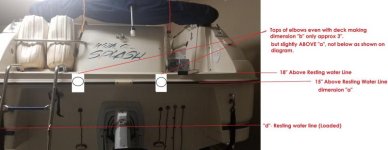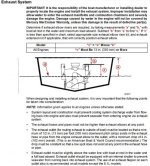Further your original post... Y pipe.. Mine was cut off a couple of inches above the "join". After wire brushing the inside and cleaning it, I coated it with life calk and then inserted a rubber plug ( the one with the "thermos" style lever seal) in each leg. I then filled the area above it with "life calk", let it cure and then installed neoprene caps over the ends with band clamps. A bit of a belt and suspenders approach. If you remove the Y pipe, you will need to block the thru transom shield hole. I think there is a Volvo part for this. otherwise you will have to fab a blocking plate. I removed the exhaust hose and installed a cork plug coated with life calk and a neoprene cap from the outside over the exhaust hose flange..( OK, I'm anal!)
Re: maximum exhaust backpressure.... The MERC Engine Installation manual for the engine had this number (2 psi). Seriously doubt that this number does not apply to all marine V8 engines. See below...
To measure exhaust back pressure I drilled a 1/32" hole at a 45 degree angle facing aft into the hose downstream of the elbow. I wet the end of a football inflation needle with soapy water and inserted it into the hole. I hooked up a tire pressure gauge that read down to 1 psi and started and ran the engine, at the dock and on the water ( a two person job for safety). When done I removed the needle. The hole eventually self sealed, while it "leaked" there were only a few residual soap bubbles. Drilling the hole at an angle encourages self sealing. I checked the tire pressure gauge with 20 ft of vertical clear plastic tubing marked every foot ( i.e. a DIY manometer) and a hand pump. The gauge was within 1/4 psi of the manometer readings. 1 foot of water = 0.43 psi.
UPDATE.... Found my original test notes..
"In Neutral... idle, 1000,1500 and 2000 RPM = <1 PSI
2500 RPm = 2.0 PSI
3000 RPM = 2.5 PSI
3500 RPM = 3.0 PSI
4000 RPM = 3.5 PSI
IN Gear... idle, 1000 and 1500 RPM = <1 PSI
2000 RPM = 2.0 PSI
2500 RPM = 3.5 PSI
3000 RPM = 5.5 PSI
3500 RPM = 6.0 PSI
3800 RPM = 6.5 PSI
Note these readings were taken with a 270 series "Y" pipe with only 1 bypass hole, not two for a total area of 6.1 sq inches. While the correct "Y" pipe has two bypass holes, its total area is only 0.78 sq inches more than the single bypass hole one. The difference between 6.1 sq inches and 6.8 is not enough to make a difference when it's supposed to be 12.5 sq inches! Going forward for me: Change exhaust to thru transom via mufflers (NJ state law) Advise to all... 5.7L engines should not
exhaust thru the leg on any drive up to and including 280/290. BTW... this is NOT a MERC vs Volvo engine issue. A 5.7L engine at 260 HP will flow the same amount of exhaust gas at a given RPM/extracted HP REGARDLESS of who made the engine. Exhaust scavenging (vacuum) from boat motion not enough to offset undersized exhaust port size."
View attachment MERC_INSTALL_MAN_86017501_EXHAUST SPECS.pdf


